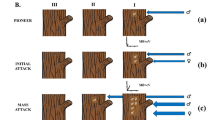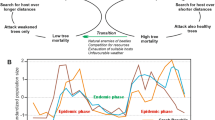Abstract
The use of semiochemicals in pest management systems of bark beetles is viewed in relation to optimization of resources investment, comparing beetle numbers in univoltine, requisitegoverned woodboringTrypodendron lineatum (Oliv.) with multigeneration bark inhabitingIps typographus (L.). The efficiency of different numbers of and distance between traps and pheromone load of dispensers was analysed using steady state models and comparing results with published and own field data. Competition between traps and beetle-infested logs, attractive distance and overlap of pheromone plume was compared forT. lineatum using models which assume a GAUSS distribution of concentration decrease around a pheromone source. For (+)-lineatin (reaction threshold 0.1 ng/m3, production 6.43 ng/♀/d, duration of production 3 d/♀), 100,000 ♀♀/ha and a flight period of 2 weeks, daily mean production is 128.6 μg/ha. Attractive distance xmax is 20–40 cm for 1T. lineatum-♀ and 13–16 m for a trap with 1 CONREL-dispenser (mean release rate 10 μg/d (+)-lineatin). A 10-fold increase of attractive distance xmax needs a 100-fold increase of pheromone release rate according to the model, and 200-fold according to field experiments.
In field experiments, Coleoptera (esp. Staphylinidae and Rhizophagidae) were the most abundant non-target trap catches. Insecticide-treated trap logs had the widest range of non-target insects including orders that were not affected by the non-insecticide trapping systems. Mass trapping can be successful in logging areas and/or forests. However, the exclusion of non-target insects still is an unsolved problem and we still have only limited knowledge on potential population increase of beetles and maximum reduction that can be achieved by trapping. Also, population levels reduced by mass trapping can be compensated by increasing reproductive effort of the succeeding generation and/or competitive displacement by secondary bark beetle species.
Zusammenfassung
Mit theoretischen Modellen kann die Effektivität verschiedener Ansätze (z. B. Fallenzahl und-abstand, Ködermenge und-abgaberate) für den Einsatz von synthetischen Pheromonen in Pest-Management-Systemen verglichen werden. Das GAUSS-sche Modell, das von einer Normalverteilung der Konzentrationsabnahme um eine Lockstoffquelle ausgeht, wurde benutzt, um fürT. lineatum die lockwirksame Reichweite und die Konkurrenzsituation von Naturköder und Falle abzuschätzen. Bei 100 000 ♀♀/ha und 2 Wochen Flugdauer ergeben sich für (+)-Lineatin (Reaktionsschwelle 0,1 ng/m3, Produktion 6,43 ng/♀/d, Produktionsdauer 3 d/♀) mittlere Tagesraten von 128,6 μg/ha bzw. eine Gesamtproduktion von 1,929 mg/ha. Die lockwirksame Reichweite xmax beträgt je nach Wetterlag für 1T. lineatum-♀ 20–40 cm, für Fallen mit 1 CONREL-Faser (Abgaberate 10 μg/d [+]-Lineatin) 13–16m. Für eine 10fach höhere lockwirksame Reichweite sind nach dem Modell etwa 100fach, in der Praxis nach verschiedenen Autoren sogar 200fach stärkere Köder erforderlich.
In Freilandversuchen über die Relation von Fangleistung und Beifängen unterschiedlicher Fangsysteme waren die Coleoptera (bes. Rhizophagidae und Staphylinidae) am häufigsten. In Trichterfallen lagen die Beifänge mit 9,2% deutlich höher als in Schlitzfallen (1,2%). Das Giftpolter hatte demgegenüber das größte Beifangspektrum; hier traten auch Ordnungen auf, die von anderen Fangsystemen nicht betroffen waren.
Massenfang kan prinzipiell in Holzhöfen und Waldbeständen erfolgreich durchgeführt werden. Allerdings ist das Problem der Beifänge noch ungelöst und die Relations von potentieller Vermehrung der Borkenkäfer und maximal möglicher Populationsreduzierung durch Fallenfang unbekannt. Zudem kann eine nach Massenfang geringere Populationsdichte im Folgciahr durch zunehmende Reproduktionsraten oder durch ersatzweise Einnischung (competive displacement) anderer Borkenkäferarten ausgeglichen und damit der Forstschutzeffekt zunichte gemacht werden.
Similar content being viewed by others
Literaturverzeichnis
Bakke, A., 1982: The utilization of aggregation pheromone for the control of the spruce bark beetle. 219–229, in:Leonhardt, B. A. & Beroza, M. (eds.), Insect pheromone technology: Chemistry and applications. ACS Symp. Ser. 190.
Bakke, A.; Lie, R., 1989: Mass trapping. 67–87, in:Jutsum, A. R., Gordon, R. F. S. (eds.), Insect pheromones in plant protection. J. Wiley Ltd.
Barclay, H.;Driessche, P. v. d., 1983: Pheromone trapping models for insect pest control. Res. Pop. Ecol.25, 105–115.
Berryman, A. A.;Raffa, K. F.;Millstein, J. A.;Stenseth, N. C., 1989: Interaction dynamics of bark beetle aggregation and conifer defense rates. Oikos56, 256–263.
Birgersson, G.;Schlyter, F.;Löfqvist, J.;Bergström, G., 1984: Quantitative variation of pheromone components in the spruce bark beetleIps typographus from different attack phases. J. chem. Ecol.10, 1029–1055.
Birgersson, G.;Bergström, G., 1989: Volatiles released from individual spruce bark beetle entrance holes: Quantitative variations during the first week of attack. J. chem. Ecol.15, 2465–2483.
Borden, J. H.;McLean, J. A., 1981: Pheromone-based suppression of ambrosia beetles in industrial timber processing areas. 133–154, in:Mitchell, E. R. (ed.), Management of insect pests with semiochemicals: concepts and practice. Plenum Press, New York, London, 514 pp.
Bossert, W. H.;Wilson, E. O., 1963: The analysis of olfactory communication among animals. J. theor. Biol.5, 443–469.
Browne, L. E.;Wood, D. L.;Bedard, W. D.;Silverstein, R. M.;West, J. R., 1979: Quantitative estimates of the Western Pine beetle attractive pheromone components, exo-brevicomin, frontalin, and myrcene in nature. J. chem. Ecol.5, 397–414.
Buda, V., 1983: Spatial structure of multicompound pheromone signal of lepidopteran females. 169, in:Darvas, B. (ed.), Int. Conf. integrated plant protection. Budapest.
Bussler, H., 1986: Zur Problematik der Borkenkäfer-Bekämpfung mit Flachtrichterfallen. Natur u. Landschaft61, 340–343.
Byers, J. A.;Anderbrant, O.;Löfqvist, J., 1989: Effective attraction radius: A method for comparing species attractants and determining densities of flying insects. J. chem. Ecol.15, 749–765.
Christiansen, E.;Waring, R. H.;Berryman, A. A., 1987: Resistance of conifers to bark beetle attack: Searching for gegeral relationships. For. Ecol. Manag.22, 89–106.
Dubbel, V., 1985: Untersuchungen zum Einsatz von Lockstoff-Fallen gegen den gestreiften NutzholzborkenkäferTrypodendron lineatum Oliv. Diss. Forstl. Fak. Freiburg/Br., 91 pp.
Dusenbery, D. B., 1989: Optimal search direction for an animal flying or swimming in a wind or current. J. chem. Ecol.15, 2511–2519.
Fares, Y.;Sharpe, P. J. H.;Magnuson, C. E., 1980: Pheromone dispersion in forests. J. theor. Biol.84, 335–359.
Furuta, K.;Takahashi, I.;Ando, S.;Inoue, M., 1985: Reproduction and mass trapping ofIps typographus japonicus NIIJMA (Coleoptera; Scolytidae) in wind damaged forest in Hokkaido. Bull. Tokyo Univ. Forests74, 39–65.
Giguere, L. A.;Delage, A.;Dill, L. M.;Gerritsen, J., 1982: Predicting encounter rates for zooplancton: a model assuming a cylindrical encounter field. Can. J. Fish. Aquat. Sci.39, 237–242.
Grünwald, M., 1986: Ecological segregation of bark beetles (Coleoptera, Scolytidae) of spruce. Z. ang. Ent.101, 176–187.
Haack, R. A.;Wilkinson, R. C.;Foltz, J. L., 1987: Plasticity in life-history traits of the bark beetleIps calligraphus as influenced by phloem thickness. Oecologia (Berl.)72, 32–38.
Hanna, S. R., 1981: Handbook on atmospheric diffusion models. World Met. Org., 86 pp.
Hanna, S. R.; Briggs, G. A.; Hosker, R. P. jr., 1982: Handbook on atmospheric diffusion. Techn Inf. Cent. USDE DOE/TIC 11223, 102 pp.
Helland, I. S.;Hoff, J. M.;Anderbrant, O., 1984: Attraction of bark beetles (Coleoptera: Scolytidae) to a pheromone trap: Experiment and mathematical models. J. chem. Ecol.10, 723–752; 11/1985, 407.
Irwin, J. S., 1978: Estimating plume dispersion — a recommended generalized scheme. 4th. Symp. Am. Met. Soc., 62–69.
Klimetzek, D., 1984: Grundlagen einer Überwachung und Bekämpfung der Nutzholzborkenkäfer (Trypodendron spp.) mit Lock- und Ablenkstoffen. Freiburger Waldsch.-Abh.,5, 1–227.
Klimetzek, D., 1990: Fichtenanbau und Fichtenschädlinge in Mitteleuropa. Schweiz. Z. Forstwes.141, 447–461.
Klimetzek, D., 1992: Schädlingsbelastung der Waldbäume in Mitteleuropa und Nordamerika. Forstwiss. Cbl. (in lit.).
Klimetzek, D.;Francke, W., 1980: Relationship between the enantiomeric composition of α-pinene in host trees and the production of verbenols inIps species. Experientia36, 1343–1345.
Klimetzek, D.;Vité, J. P.;Mori, K., 1980: Zur Wirkung und Formulierung des NutzholzborkenkäfersTrypodendron (=Xyloterus) lineatum. Z. ang. Ent.89, 57–63.
Klimetzek, D.;Vité, J. P.;König, E., 1981: Über das Verhalten mitteleuropäischerTrypodendron-Arten gegenüber natürlichen und synthetischen Lockstoffen. Allg. Forst- u. Jagdztg.152, 64–70.
Klimetzek, D.;Köhler, J.;Vité, J. P.;Kohnle, U., 1986: Dosage response to ethanol mediates host selection by “secondary” bark beetles. Naturwiss.73, 270–272.
Klimetzek, D.; Schlenstedt, L., 1991: Waldschutz gegen Borkenkäfer: Pheromone oder Insektizideinsatz? Jahresber. Hess. Forstverein (im Druck).
König, E., 1988: Mass-trapping ofTrypodendron lineatum Ol. (Col., Scolytidae): Effect of infestation of cut timber temporarily left in the forest. Z. ang. Ent.106, 262–265.
Kohnle, U.; Klimetzek, D., 1984: Behavioral chemicals in the competitive displacement of bark beetles affecting Norway Spruce. 17th Int. Congr. Ent, (Hamburg/FRG), 587.
Kretschmer, K., 1991: Zur Problematik der Beifänge beim Einsatz von Aggregationspheromonen. Mitt. Biol. Bundesanst. Land- u. Forstwirtsch.267, 101–110.
Krol, A.;Bakke, A., 1985: Effect of distance between the pheromone traps on the effectiveness of the spruce bark beetle (Ips typographus L.) aggregation. Acta agars. silv. (Ser. silv.)24, 21–30.
Lindgren, B. S.;Borden, J. H., 1983: Survey and mass trapping of ambrosia beetles (Coleoptera: Scolytidae) in timber processing areas on Vancouver Island. Can. J. For. Res.13, 461–493.
Lindgren, B. S.;Borden, J. H.;Chong, L.;Friskie, L. M.;Orr, D. B., 1983: Factors influencing the efficiency of pheromone-baited traps for three species of ambrosia beetles (Coleoptera: Scolytidae). Can. Ent.115, 303–313.
Maksymov, J. K.;Jansen, E.;Jäggi, P., 1982: Synthetische Pheromone des BuchdruckersIps typographus (L.); ein wirksames Mittel zu seiner Bekämpfung. Schweiz. Z. Forstwes,113, 1029–1044.
Martin, D. O., 1976: The change of concentration standard deviation with distance. J. Air. Poll Contr. Ass.26, 145.
Mills, N. J., 1986: A preliminary analysis of the dynamics of within tree populations ofIps typographus (L.) (Coleoptera: Scolytidae). Z. ang. Ent.102, 402–416.
Mosbacher, G. C., 1987: Insekten aus Borkenkäferfallen II. Coleoptera excl. Scolytidae. Faunistisch-floristische Notizen aus dem Saarland19, 505–542.
Nakamura, K., 1982: Competition between females and pheromone traps: time lag between female mating activity and male trap catches. Appl. Ent. Zool.17, 292–300.
Nicolai, V., 1986: The bark of trees: thermal properties, microclimate and fauna. Oecologia (Berlin)69, 148–160.
Niemeyer, H., 1985: Test und Effektivität von Borkenkäferfallen. Forst- u. Holzwirt40, 32–40.
Novak, J.;Cermak, J., 1986: Estimation of volatile substances in the atmosphere of forest ecosystems by gas chromatography. Intern. J. Env. An. Chem.24, 1–22.
Payne, T. L.;Klimetzek, D.;Kohnle, U.;Mori, K., 1983: Electrophysiological and field responses ofTrypodendron spp. to enantiomers of lineatin. Z. ang. Ent.95, 272–276.
Schlenstedt, L., 1992: Pheromoneinsatz in der Forstwirtschaft: Technologie Transfer und Aussichten. Diss., Forschwiss. Fak., Univ. Freiburg/Br. (in Vorb.).
Schlyter, F.;Anderbrant, O.;Harding, S.;Ravn, H. P., 1984: Offspring per emergence hole at different attack densities in the spruce bark beetle,Ips typographus (L.) (Coleoptera, Scolytidae). Z. ang. Ent.97, 244–248.
Schlyter, F.;Byers, J. A.;Löfqvist, J., 1987: Attraction to pheromone sources of different quantity, quality, and spacing: density-regulation mechanisms in bark beetleIps typographus. J. chem. Ecol.13, 1503–1523.
Schwartz, L., 1989: Nebenwirkungen von Falle und Fangbaum in der Borkenkäfer-Bekämpfung. Dipl.-Arb., Forstwiss. Fak., Univ. Freiburg, 76 pp.
Singer, J. A.;Smith, M. E., 1966: Atmospheric dispersion at Brookhaven Laboratory. Int. J. air water poll.10, 125.
Stanley, B. H.;Hummel, H. E.;Ruesink, W. G., 1985: Estimating maximum horizontal area of pheromone plumes. J. chem. Ecol.11, 1129–1146.
Sutton, O. G., 1953: Micrometeroology. McGraw-Hill, New York 333 pp.
Thompson, W. A.;Wellington, W. G.;Vertinsky, I. B.;Matsumura, E. M., 1977: Harvesting strategies, control styles and information levels: a study of planned disturbances to a population. Res. Popul. Ecol.18, 160–176.
Vaupel, O.;Dimitri, L.;König, E.;Berwig, W., 1987: Pheromonfallen sind kein Ersatz für Walhygiene. Allg. Forstz.42, 90–92.
Wall, C.;Perry, J. N., 1987: Range of action of moth sexattractant sources. Ent. Exp. & Appl.44, 5–14.
Wang, L. K.;Wang, M. H.;Bergenthal, J., 1981: Predicting the dispersion of airborne effluents for environmental management. J. envir. Manag.12, 247–270.
Weber, E. (ed.), 1982: An pollution: Assessment methodology and modeling — (Plenum Press, New York & London, 329 pp.
Weber, T., 1987: Sind Borkenkäfer durch Pheromon-Fallen wirksam zu bekämpfen? Allg. Forstz.42, 87–89.
Weslien, J.;Annila, E.;Bakke, A.;Beyer, B.;Eidmann, H. H.;Narvestad, K.;Nikula, A.;Ravn, H. P., 1989: Estimating risks for spruce bark beetle (Ips typographus [L.]) damage using pheromone-baited traps and trees. Scand. J. For. Res.4, 87–98.
Wood, D. L., 1982: The role of pheromones, kairomones, and allomones in the host selection and colonization behavior of bark beetles. Ann. Rev. Ent.27, 411–446.
Zhong, H.;Schowalter, T. D., 1989: Conifer bole utilization by wood-boring beetles in western Oregon. Can. J. For. Res.19, 943–947.
Author information
Authors and Affiliations
Additional information
Herrn Prof. Dr. Dr.G. Wellenstein zum 85. Geburtstag.
Mit 5 Abbildungen und 2 Tabellen
Mit Unterstützung der Deutschen Forschungsgemeinschaft.
Nach einem Vortag bei der Fortbildungstagung des Hessischen Forstvereins in Solms/Lahn am 23. Mai 1991.
Rights and permissions
About this article
Cite this article
Klimetzek, D., Schlenstedt, L. Waldschutz gegen Borkenkäfer: Der Beitrag von Duftstoffmeteorologie und Populationsdynamik. Anz. Schadlingskde., Pflanzenschutz, Umweltschutz 64, 121–128 (1991). https://doi.org/10.1007/BF01906002
Issue Date:
DOI: https://doi.org/10.1007/BF01906002




